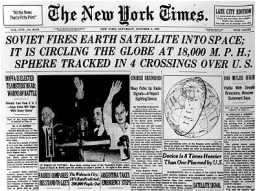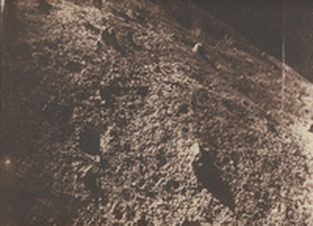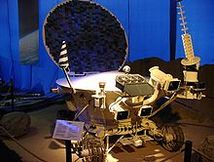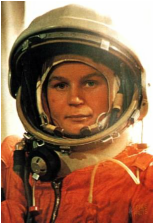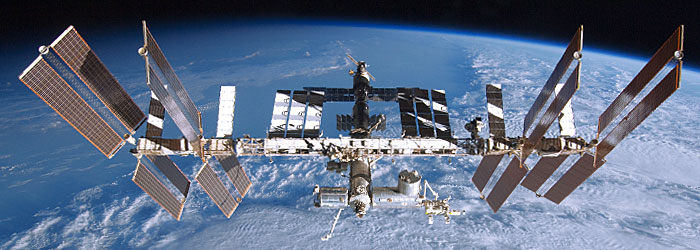The first nation in space, and more Russian firsts
In the early years of the Space Age, Russia achieved an extraordinary range of record-breaking ‘firsts’.
|
Russia surprised the world on 4 October 1957 by inaugurating the Space Age with the launch of its satellite Sputnik. It was an incredible technical achievement which impressed scientists and the public around the globe, not least the Americans who were still working to prepare their own satellite for launch.
|
A month later, the world’s second satellite was also launched by Russia, or the USSR as it was then known. Sputnik carried the first living creature into space, a Moscow street dog called Laika. Although Laika was not able to return to Earth and died in space, she proved that animals and therefore probably humans could survive in orbit.
Luna 1, or ‘Mechta’, was launched in 1959 and became the first craft to escape from close Earth orbit. Although it missed its intended target, Luna 2 succeeded later that year, crashing into a flat plain on the Moon called the Mare Imbrium, or Sea of Rains, and becoming the first craft to reach a celestial body.
Luna 3 followed, making a historic journey around the Moon and sending back photos of the previously-unknown far side of the Moon. Some features were named for the first time, such as the Moscow Sea and the crater Tsiolkovsky, after the Russian rocket pioneer.
Luna 1, or ‘Mechta’, was launched in 1959 and became the first craft to escape from close Earth orbit. Although it missed its intended target, Luna 2 succeeded later that year, crashing into a flat plain on the Moon called the Mare Imbrium, or Sea of Rains, and becoming the first craft to reach a celestial body.
Luna 3 followed, making a historic journey around the Moon and sending back photos of the previously-unknown far side of the Moon. Some features were named for the first time, such as the Moscow Sea and the crater Tsiolkovsky, after the Russian rocket pioneer.
|
With Luna 9 in 1966, the first soft landing on the Moon was accomplished. The craft sent back pictures of a gravelly surface, some rocks, craters and black sky. Luna 9’s signals were picked up by Jodrell Bank radio telescope near Manchester and its photos were first published in the British press.
|
During the 1960s and 70s, Russia launched a campaign of unmanned space flights to the planet Venus. It sent the first-ever space probe to a planet, Venera 3, and later missions sent back remarkable colour photographs of the hellish surface of Venus, a landscape of cracked rocks, crushing atmospheric pressure and temperatures of 500 degrees C.
Returning to the Moon, Russia managed to bring back moon rocks to Earth without human intervention when a small capsule from Luna 16 parachuted back to Kazakhstan in 1970. The Americans, however, had already succeeded in this task with their first two manned landings on the Moon. Further Russian missions returned samples from other locations on the Moon.
Returning to the Moon, Russia managed to bring back moon rocks to Earth without human intervention when a small capsule from Luna 16 parachuted back to Kazakhstan in 1970. The Americans, however, had already succeeded in this task with their first two manned landings on the Moon. Further Russian missions returned samples from other locations on the Moon.
Turning to humans in space, the pioneering flight of Yuri Gagarin in 1961 is well known (see separate story). Russian also achieved the first multiple spaceflight when Vostoks 3 and 4 went into space at the same time. Cosmonauts Nikolayev and Popovich talked by radio and approached to within 5 km of each other.
The Vostok capsule was then modified to become first a two-person spacecraft, then a three-person one, called Voskhod, meaning Sunrise. From Voskhod 1, legendary cosmonaut Alexie Leonov made the world’s first spacewalk, floating outside his craft attached by a safety line for 20 minutes. Voskhod 2 was the first time three people travelled into space together, including the first doctor.
Russia succeeded in the first link-up in space of two manned craft in 1969. After the docking, cosmonauts Khrunov and Yeliseyev transferred from Soyuz 5 to Soyuz 4 and returned to Earth in a different craft from the one they launched in.
In 1971, Salyut (meaning ‘Salute’ as a tribute to Yuri Gagarin) became the world’s first space station in orbit around the Earth. Later Salyut stations, and the larger space station Mir (meaning ‘Peace’ or ‘World’), were visited by many Russian and international crews travelling in Soyuz ferry craft during the 1970s, 80s and 90s. The Soyuz was used in a historic space docking with the USA in 1975, again involving spacewalking cosmonaut Alexei Leonov. Alexei still lives in Moscow and talks eloquently about his space flights.
The three-person Soyuz is still in use after several upgrades, and is the world’s most reliable manned spacecraft.
Today, Soyuz remains the mainstay of support for the International Space Station, being currently the only way in which Russian, American, European, Canadian and Asian astronauts can travel to and from the ISS in its endless orbits around the Earth.
Russia succeeded in the first link-up in space of two manned craft in 1969. After the docking, cosmonauts Khrunov and Yeliseyev transferred from Soyuz 5 to Soyuz 4 and returned to Earth in a different craft from the one they launched in.
In 1971, Salyut (meaning ‘Salute’ as a tribute to Yuri Gagarin) became the world’s first space station in orbit around the Earth. Later Salyut stations, and the larger space station Mir (meaning ‘Peace’ or ‘World’), were visited by many Russian and international crews travelling in Soyuz ferry craft during the 1970s, 80s and 90s. The Soyuz was used in a historic space docking with the USA in 1975, again involving spacewalking cosmonaut Alexei Leonov. Alexei still lives in Moscow and talks eloquently about his space flights.
The three-person Soyuz is still in use after several upgrades, and is the world’s most reliable manned spacecraft.
Today, Soyuz remains the mainstay of support for the International Space Station, being currently the only way in which Russian, American, European, Canadian and Asian astronauts can travel to and from the ISS in its endless orbits around the Earth.
Now it's your turn!
Imagine you are a cosmonaut on the International Space Station and write a letter home (or a Facebook message?) describing your life in space.
What would Gagarin have thought of life on spaceships today?
Find out more about one of the cosmonauts mentioned on these pages - their life, their training, their experience in space - and write a short factual biography, including why you chose that person.
What would Gagarin have thought of life on spaceships today?
Find out more about one of the cosmonauts mentioned on these pages - their life, their training, their experience in space - and write a short factual biography, including why you chose that person.
|
Use our alphabet decoder to read the Russian words here and then answer the questions. All the words are names which have been mentioned on our two Space pages.
|
|
1) Can you put these spaceships in order, the earliest first: САЛЮТ ВОСХОД ЛУНА СПУТНИК СОЮЗ ВОСТОК ЛУНОХОД |
2) Which of the names below a) did not go up in space b) is not a human being c) is not a man d) is not Russian ГАГАРИН ЛАЙКА ЦИОЛКОВСКИЙ ТЕРЕШКОВА АРМСТРОНГ ЛЕОНОВ Answers |
